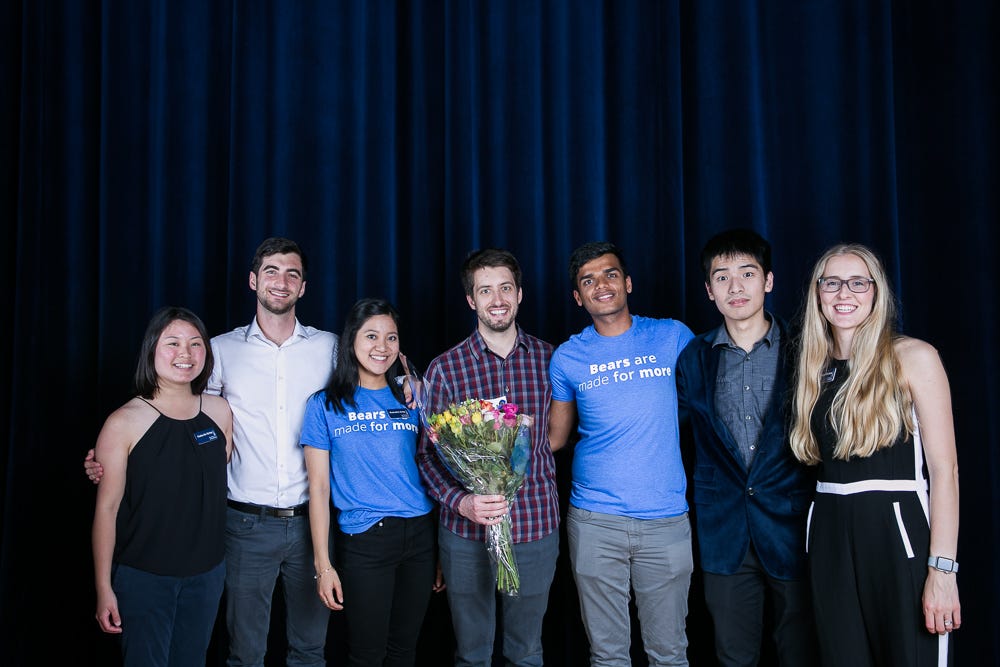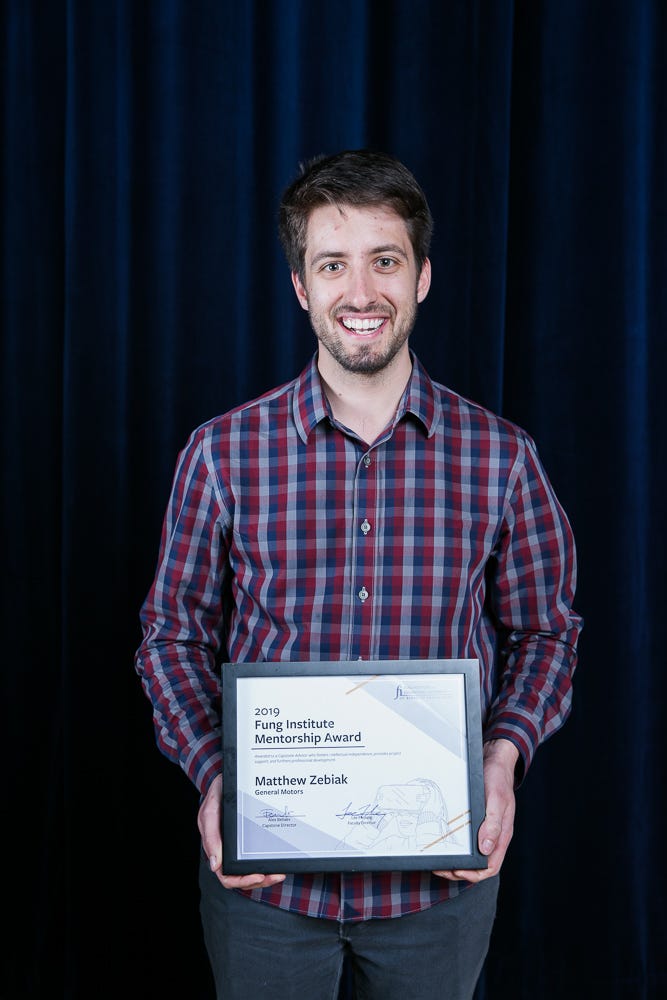“What sets MEng students apart is not only a willingness, but an eagerness to take on real-world engineering problems.”
Edited by Ashley Villanueva Capstone advisors play an integral role in the success of the Berkeley Master of Engineering (MEng) Capstone exerience program. This year, Matt Zebiak of General Motors (GM), won the MEng Capsone Mentorship Award (Industry). This recognition was awarded to the industry Capstone advisor who best fosters intellectual independence, provides project support, and furthers professional development. Matt, an MEng alumnus from the Class of 2016, served as the GM Capstone advisor for the the Modeling the Energy Impact of Autonomous Vehicles Capstone team.
Modeling the Energy Impact of Autonomous Vehicles: Smoothing the Way to Save Energy
Team: Eunice Pui [IEOR], Abby Shelton [IEOR], Shivam Mistry [IEOR], Louis du Chassin [ME], Kumudra Aung [ME], Julien Yu [IEOR] Project Description: The transportation sector was responsible for 28.5 percent of U.S. greenhouse gas emissions in 2016, but the automotive industry is trying to decrease its contribution to climate change. This project quantified the energy impact of utilizing electric autonomous vehicles (AV) over traditional human-driven vehicles through the development of two AV simulation models. The models input characteristics such as vehicle speed and motor torque of a human-driven trip on a Chevrolet Bolt and output optimized AV speed profiles. Two different models were designed and tested on data from a General Motors database: an interpolation model estimates the potential energy savings and model predictive control (MPC) understands the vehicle inputs required to generate optimized AV speed profiles. We asked Matt a few questions about his advising experience.
What is your advising philosophy? How has being a recent MEng grad informed your approach to advising?
My philosophy as an advisor has been to create a project that I know I would have found both enjoyable and valuable as a student. With the memories of my own Capstone successes and frustrations still fresh in my mind, it was a bit easier to relate to the current group of students and give them the type of environment in which they’d thrive. To this end, I strove to cut down on busy work, give them opportunities for hands-on experiences (including getting them into our cars) and provide enough structure to keep things moving without imposing my own ideas or agendas. I also tried to recognize that I’m new to advising, so I relied on the students for help and fresh ideas in moments of doubt, and this helped to steer the project in a successful direction at several critical moments.What was the most memorable moment with your team?
I can’t narrow it down to just one, but I’ll give you two moments that were memorable for very different reasons. The first was from our data-collection ride trip to Yosemite back in September — I recall seeing the students, who had only known each other for at most a couple of weeks, standing on top of the Lembert Dome taking selfies and generally goofing around. You never quite know how team dynamics are going to work out, especially when you select team members remotely, so this was the moment when I knew we’d lucked out and selected a terrific group that would work well (and play well) together. The next moment was from the day before the showcase — the students were strung out from lack of sleep, thinking about upcoming finals and project deadlines, but managed to make the final push in the last 24 hours to put together a tremendous interactive demo. As the racing simulator we used began to take shape, you could feel the tension being removed from the air, and excitement taking over as the students got ready to show off their year of hard work.What’s unique about Berkeley MEng students compared to students from other universities?
I’d say what sets Berkeley MEng students apart is not only a willingness, but an eagerness to take on real-world engineering problems with all of their associated baggage. With other students, I may have felt guilty bringing them a problem with such a broad scope, asking them to use data with quality issues, and requiring that they deal with company bureaucracy and an advisor living across the country. However, these students are eager to understand what it’s like to tackle engineering problems in the real world so they can enter the workforce prepared, even if it means dealing with logistical annoyances you’d never see in an academic setting. This is a unique quality that will set these students up to be ahead of the game in industry, and leaders wherever they go.What sets Berkeley MEng students apart is not only a willingness, but an eagerness to take on real-world engineering problems.
What led you to propose an MEng Capstone project?
The Capstone project honestly seemed like a perfect match for GM and Berkeley, after I spent some time as both a student and employee. After all, a large company with lots of questions and resources, but not much time to investigate curiosities is perfectly complemented by a bright student group with dedicated time for research, in search of industry experience. We benefitted a ton from working with the students, and my hope is that the partnership was just as fruitful for them. How did you go about recruiting your team? I ran the team selection process like GM runs the recruiting process for new hires. I remember, as a student, enjoying the practice of interviewing for Capstones before interviewing for jobs, so I designed some questions that would give me a sense of their interest and qualifications, and give them the chance to practice for other interviews. Because there were so many students to contact in so little time, I didn’t schedule anything — I just posted my phone number next to the questions and told them to cold call me when they were ready (this is a crazy but necessary process when advising remotely). All in all, it was a stressful but rewarding experience on my side, and I’m just thrilled that I got to meet so many qualified and interested students as part of the process.What advice would you give to industry partners who’ll be advising a Capstone team in the future?
Let the students run a little wild with their ideas! Frequently solicit feedback, and don’t sweat it if you start to deviate from your original plans for the year. Even if the students might not be experts in the field just yet, sometimes fresh ideas and perspectives can lead to breakthroughs that you wouldn’t see as readily among experts (think about people who say “we shouldn’t do that… we’ve always done things this way”). In addition, it’s more exciting for the students to be given the opportunity to think freely, and it helps them to appreciate how much we industry partners value their contributions. How will your project be different next year / what are you planning on doing different next year? Since we arrived at such a satisfying conclusion for this project, I don’t believe there’s enough material on this subject to stretch it into a third year. Luckily, two other managers at GM decided to move forward with Capstone proposals for next year after hearing about my positive experiences, so in the spirit of “quality over quantity,” I’ve decided act as a co-advisor on both of those teams. This should ensure that the GM Capstone staff is not spread too thin, and that we’re still able to provide a positive experience for double the number of students next year.How did the Capstone team advance this technology? What was their major accomplishment? How can next year’s team continue the work?
In this developing field, there’s been a lot of research into how much energy can be saved by autonomous vehicles, when V2V (vehicle-to-vehicle) and V2I (vehicle-to-infrastructure) communications become the norm, and AVs can work together as a fleet for maximum efficiency. This is an interesting upper bound of savings, but we’ll be unable to realize these full benefits when AVs launch, since AVs will be such a small proportion of cars on the road, and these communications will still be in a nascent phase. This team instead focused on how much energy can be saved by AVs in the short-term by simply operating the vehicle (accelerator and brakes) more smoothly than the average human driver. The students constructed several strategies to “smooth” the AV drive trace subject to some constraints, and they found that about 3% of energy can be saved simply with these smoother inputs. GM will be able to learn from their models, and optimize our accelerations and decelerations to start realizing these AV energy savings from day one. Connect with Matt.Advisor Feature: Matt Zebiak, General Motors was originally published in Berkeley Master of Engineering on Medium, where people are continuing the conversation by highlighting and responding to this story.




